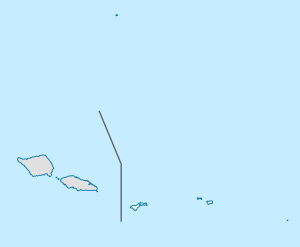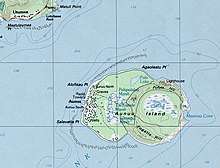Aunuʻu, American Samoa
Aunuʻu is a small volcanic island off the southeastern shore of Tutuila in American Samoa. It has a land area of 374.83 acres (0.59 sq mi; 1.52 km2) and a 2010 census population of 436 persons. Politically it is a part of the Eastern District, one of the primary divisions of American Samoa. The island is located in Saʻole County.[1][2]:424
Aunuʻu | |
|---|---|
Village & Island | |
 | |
 Aunuʻu | |
| Coordinates: 14°17′2.7″S 170°33′37.5″W | |
| Country | |
| Territory | |
| County | Saʻole |
| Area | |
| • Total | 1.517 km2 (0.5857 sq mi) |
| Population (2010) | |
| • Total | 436 |
| Designated | 1972 |
Faimulivai Marsh is a freshwater marsh in Aunuʻu Crater and the largest such wetland in American Samoa. It was formed from the drainage of the low-lying crater. It is part of a protected National Natural Landmark on Aunuʻu which was designated in 1972. The Pacific black duck was seen in the marsh in 1976, but it may now be extinct in the region; another significant local bird is the purple swamphen. This marsh is the only place in American Samoa that has Chinese water chestnut.
The main sources of economic activity for the Aunuʻu people since the 1960s have been taro and production of faausi.[3]
Geography

Aunuʻu, which is a small island at the southeast tip of Tutuila, has three villages: [[Saluavatia]the second Vatia former resident of Paramount Chief Gaoteote], Leaouliuli, and Alofasau. However, politically the tulafale divides it into two sections, Saleaaumua and Saole. To Saole belongs all of Saluavatia and half of Leaouliuli whose other half together with Alofsau make up Aunuʻu is a car-free island. Motorboats shuttle constantly over to the small boat harbor at Auasi. The island has a lake, Red Lake, which is nestled in the sprawling crater. The island is densely forested and cliffs along the south coast along with the thick bushes make hiking the island difficult. The island has a stretch of red quicksand at Pala Lake, fairly close to the village. There are also taro swamps behind the village. Maʻamaʻa Cove is a cove on the east side of Aunuʻu.[4][5]
Geology
The island is less than 1 sq. mi. in area and around half the island is a cultivated plain on which the village of Aunuʻu is located. The island is home to several beaches composed of coral rubble and sand and sea cliffs. The eastern half of Aunuʻu is rimmed by a geologically recent volcanic cone. The highest point on the crater rim is 310 feet above sea level. Within the crater is the Faʻimulivai Marsh which includes a freshwater pond. The crater is one of few places in American Samoa where one can observe the more recent episodes of volcanism. The eruptions at Aunuʻu occurred at approximately the same time as the volcanism at Leala Shoreline in Taputimu, while eruptions that formed Rainmaker Mountain, Matafao Peak, and the ridges of Vaiʻava Strait are much older. Aunuʻu Island has the only quicksand area in American Samoa, and also the territory's only lake. Just north of the village is Pala Lake, while Maʻamaʻa Cove is on the far eastern edge of the crater.[6]
Wildlife
Aunuʻu has a population of around fifty gray ducks (anas superciliosa), locally known as toloa. Pairs of these birds have also been sited in Futiga, Nuʻuuli, Alao, and Leone, however, these may be from the population on Aunuʻu.
References
- Tuʻuʻu, Misilugi Tulifau Tofaeono (2002). History of Samoa Islands: Supremacy & Legacy of the Malietoa (na Faʻalogo i Ai Samoa). Tugaʻula Publication. Page 427. ISBN 9780958219914.
- Krämer, Augustin (2000). The Samoa Islands. University of Hawaii Press. ISBN 9780824822194.
- http://www.radionz.co.nz/international/pacific-news/230665/american-samoa-govt-keen-to-develop-aunu'u-island
- Stanley, David (2000). South Pacific Handbook. David Stanley. Page 444-445. ISBN 9781566911726.
- Stanley, David (2004). Moon Handbooks South Pacific. David Stanley. Page 479. ISBN 9781566914116.
- Goldin, Meryl Rose (2002). Field Guide to the Samoan Archipelago: Fish, Wildlife, and Protected Areas. Bess Press. Pages 281-282. ISBN 9781573061117.
- "American Samoa Statistical Yearbook 2016" (PDF). American Samoa Department of Commerce. Archived from the original (PDF) on 2019-02-14. Retrieved 2019-07-25.